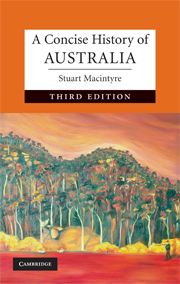Book contents
- Frontmatter
- Contents
- List of illustrations
- Acknowledgements
- Map 1.1 Australia: the main rivers, cities and towns
- 1 Beginnings
- 2 Newcomers, c. 1600–1792
- 3 Coercion, 1793–1821
- 4 Emancipation, 1822–1850
- 5 In thrall to progress, 1851–1888
- 6 National reconstruction, 1889–1913
- 7 Sacrifice, 1914–1945
- 8 Golden age, 1946–1974
- 9 Reinventing Australia, 1975–2008
- 10 What next?
- Sources of quotations
- Guide to further reading
- Index
5 - In thrall to progress, 1851–1888
- Frontmatter
- Contents
- List of illustrations
- Acknowledgements
- Map 1.1 Australia: the main rivers, cities and towns
- 1 Beginnings
- 2 Newcomers, c. 1600–1792
- 3 Coercion, 1793–1821
- 4 Emancipation, 1822–1850
- 5 In thrall to progress, 1851–1888
- 6 National reconstruction, 1889–1913
- 7 Sacrifice, 1914–1945
- 8 Golden age, 1946–1974
- 9 Reinventing Australia, 1975–2008
- 10 What next?
- Sources of quotations
- Guide to further reading
- Index
Summary
At the end of 1850 Edward Hargraves returned to Sydney from a year on the other side of the Pacific. He was one of the ‘fortyniners’ who had converged on California in search of gold. Although unsuccessful in that quest, Hargraves was struck by the similarity between the gold country there and the transalpine slopes of his homeland. In the summer of 1851 he crossed the Blue Mountains to Bathurst and washed a deposit of sand and gravel from a waterhole to disclose a grain of gold in a tin dish. ‘This is a memorable day in the history of New South Wales,’ he told his companion. ‘I shall be a baronet, you will be knighted, and my old horse will be stuffed, put into a glass-case, and sent to the British Museum.’ Hargraves named his place of discovery Ophir and set off back to Sydney to claim a reward from the governor.
Hargraves was not the last Australian miner to engage in self-promotion or seek public recognition and reward. He was not even the first colonist to find gold: shepherds had picked up nuggets from rocky outcrops, and a clerical geologist collected many such specimens. In 1844 this scientist showed one to Governor Gipps and claimed that he was advised ‘Put it away, Mr Clarke, or we shall all have our throats cut.’ This again was one of the tall tales spun from the precious metal.
- Type
- Chapter
- Information
- A Concise History of Australia , pp. 86 - 121Publisher: Cambridge University PressPrint publication year: 2009



